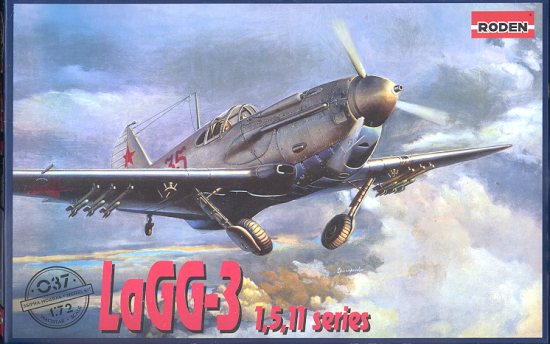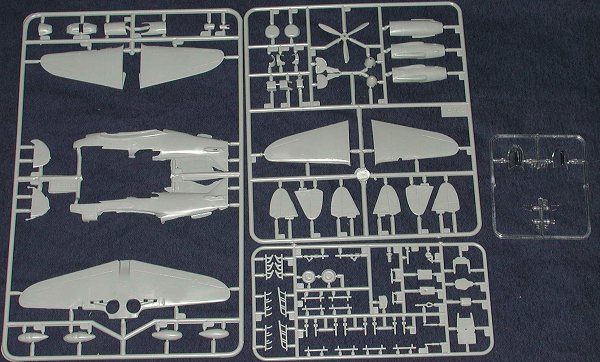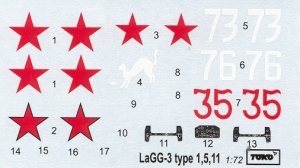
|
KIT: |
Roden 1/72 Lagg-3 Series 1,5,11 |
|
KIT # |
0037 |
|
PRICE: |
$8.98 MSRP |
|
DECALS: |
N/A |
|
REVIEWER: |
|
|
NOTES: |
D |

|
HISTORY |
LaGG stands for Lavochkin, Gorbunov and Gudkov. Prior to this aircraft, only Lavochkin had ever designed a plane. Primary material for the LaGG fighter was a material called Delta. It was a sandwich of layers of birch strips which were glued cross-grained, impregnated with glue and used with bakelite plies. This was mainly because the Soviet Union was rather deficient in aluminum so anything that could be used to replace it was highly sought.
The first plane from this design shop was the I-22. There was much expected from it as it was an exceptionally clean design and powered by a Klimov M-105P engine of 1,050 hp. However, due to the large amount of wood in its construction, it was about 600-700 lbs heavier than the mostly aluminum competitor from Yakovlev and his I-26. However, the I-22 met requirements and was moved ahead for further development.
Since greater range than the 370 miles of the I-22 were desired, the I-301 had wing tanks installed that increased the range. It managed to reach a speed of 312 mph at ground level and 376 mph at 16000 feet, making it faster than the Yak I-26 at altitude. During this time (1940) the Soviets received several Bf-109E-3 aircraft and the I-301 was tested against it. It was found that the I-301 outperformed it at altitude and also was more maneuverable. A production order was initiated in mid 1940 as it was obvious to the Kremlin that it was but a matter of time before they would be at war with Germany.
At the time of the German invasion in June of 1941, there were 322 Lagg-3 fighters available to Soviet forces. The majority of these were the series 1. They had an armament of three 12.7mm guns and two 7.62 mm versions in the nose. One of the 12.7mm guns fired through the engine and out the spinner. The exhaust had been lengthened over that of the very similar I-301 prototype. It also had a radio antenna mast and an external rudder balance on the top and bottom of the rudder. Frankly, the radio was a waste as rarely were there many available and then they rarely worked! The Series 1 also had a larger tail wheel. The Series 5 had a 20mm cannon in the nose and the lower rudder balance weight removed. The Series 11 had the 7.62mm guns deleted and was also equipped with under wing bomb and rocket racks.
|
THE KIT |

The Roden kit is actually the Toko kit. Not surprising as it is the same company, just a new name! As a result, you'll find Toko emblazoned on everything from the sprues to the decal sheet. The kit itself is well molded, though since this is not a new kit, you'll find that things are not as crisply done as on the newer kits that Roden has been doing. However, that is not all bad, considering that the only other LaGG-3 in this scale is the ex-Frog kit produced by Red Star many years ago. (Late note: I've been informed by several readers that this kit is also done by Dakoplast. I've never seen one.) That kit was very basic indeed, consisting of few parts. Made for a fast construct, but not much detail. This one has lots of detail, in fact, it has all the different bits and pieces to do any of the LaGG-3 series. Roden, as with many model makers, had provided the exact same sprues for all of the kits. The builder merely chooses those that are needed. Really a good way to do these things.
Back to the kit itself, there is lots of detail in the interior including sidewalls, though it is not as petite as one would hope. Detailing that's present is engraved, but there isn't much of it as wooden planes just don't need it. The clear bits are a touch distorted but more than adequate for the kit. The kit cannot be built with the canopy open as it is designed, but one can easily smash mold an opening section with clear plastic or Squadron's Thermaform. As you can see from the image, the fuselage halves had quite a bit of flash. Of the three kits that will be previewed, two of them showed this trait while a third was nice and clean. Cleanup should be a breeze and it doesn't seem to have any effect on the kit itself. A few of the thicker pieces and some sink marks on them, most of which will be easy to fill.
The instructions are quite detailed as to which parts are for which series. Instrument panels are provided as decals and there are different ones for the different series. If you are doing the series 11, then there are rocket rails and rockets to mount, though it is not specified in the instructions that these are for the series 11 only. The different rudders, tail planes, spinners and engine cowlings are all provided as are the different nose intakes. You will also need to sand off the 'slats' on the leading edges of the wings as these were not fitted to the early series.
 Decals are provided for three
planes, one of each series. They are fairly well printed and matte. I've heard
of some folks having trouble with Roden/Toko decals. I'm not sure how good these
are, as I've never had the chance to use any kit decals from Roden. Perhaps
coating them with Microscale Superfilm will help. There are aftermarket decals
that were done by Superscale a few decades back. I'd suggest hunting them out if
you think there will be trouble.
Decals are provided for three
planes, one of each series. They are fairly well printed and matte. I've heard
of some folks having trouble with Roden/Toko decals. I'm not sure how good these
are, as I've never had the chance to use any kit decals from Roden. Perhaps
coating them with Microscale Superfilm will help. There are aftermarket decals
that were done by Superscale a few decades back. I'd suggest hunting them out if
you think there will be trouble.
The three aircraft are White 73, a series 1 in green and black green over light blue. The Series 5 is in a winter camo of white over light blue and is Red 35 as shown on the box art. Finally, the Series 11 plane is White 76, also in green and black-green over light blue. It has a design on the fin/rudder that looks like a weasel (but I have been informed that it is actually a cat). I might point out that I think they have the series 1 and series 11 planes in the wrong location on the decal placement sheet. At least it seems so to me. Colors are given in generic terms and Humbrol numbers.
|
CONCLUSIONS |
If you want an accurate LaGG-3 in 1/72, then this is it. I'll have one on the bench shortly and will let you know how well it builds.
|
REFERENCES |
Lagg fighters in Action, #163, Squadron/Signal Publications
Thanks to the fine folks at
 for the review kit. Visit
them by clicking on the logo.
for the review kit. Visit
them by clicking on the logo.
If you would like your product reviewed fairly and quickly by a site that has well over 175,000 visitors a month, please contact me or see other details in the Note to Contributors.